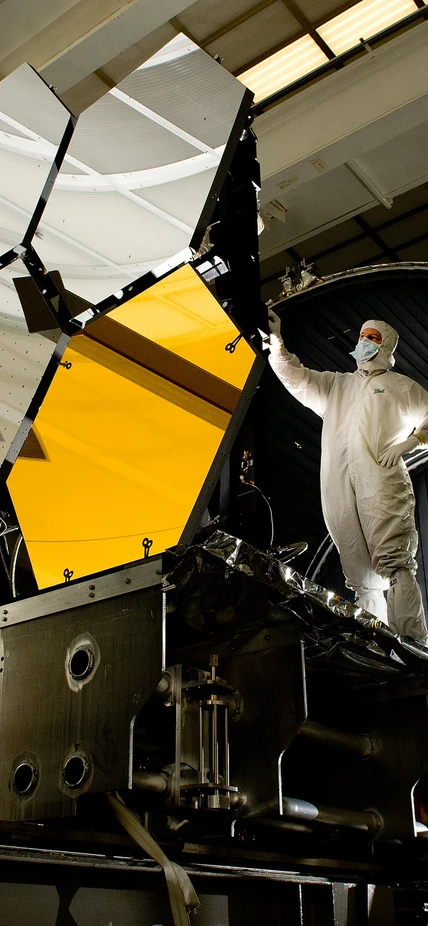A team co-led by Carnegie astronomer Johanna Teske has officially secured observation time on the James Webb Space Telescope (JWST)—NASA’s newest space telescope—when it launches later this year. Teske is the co-principal investigator and will be leading the study alongside principal investigator Natasha Batalha (NASA Ames) and their team, which also includes Peter Gao, who will start as a Carnegie staff member this fall, Munazza Alam, who will start as a Carnegie Postdoctoral Fellow this fall, and current staff member Anat Shahar.
The project (“Seeing the Forest and the Trees: Unveiling Small Planet Atmospheres with a Population-Level Framework”) will use the telescope’s near-infrared spectroscopy equipment to study the light passing through the atmospheres of 11 rocky planets that have been identified by TESS (Transiting Exoplanet Survey Satellite).
Specifically, the proposal requested JWST time to observe the atmospheres of sub-Neptunes (~2-3x the size of Earth) and super-Earths (~1-2 x the size of Earth). Planets in this size range are abundant around other stars but don’t occur in our own Solar System. More information about them may provide clues to how our own planetary system formed.
The goal of the program is to see whether there is an observable change in the presence and compositions of these planet’s atmospheres, especially as compared to their size. For example, the team will look to see whether there is a notable transition between planets with “primary” atmospheres, which planets have when they are newly formed, and planets with “secondary” atmospheres, which arise from gas escaping from their interiors.
Said Teske, “If a planet is releasing gasses into its atmosphere, we can potentially get a more detailed picture of the planetary interior by studying its atmosphere. Developing a better understanding of the interior-atmosphere interaction is critical for a better understanding of whether different planets could be habitable—it's a key component of the Carnegie Planets project here at EPL.”
One valuable feature of Teske’s proposal is that it includes several planets that are in known multi-planet systems around the same star. This will function as a control for the planet’s host star composition and activity, which are known to impact the ultimate characteristics of a planet.
Said Teske, “We constructed our sample in a way that we think is optimal for being able to make population-level inferences about super-Earths and sub-Neptunes, in addition to the planet-by-planet studies that will already be very interesting!”
Applications for this time were highly selective as astronomers from around the world bid for the opportunity to observe on the new telescope. This makes Teske’s approved program all the more impressive: NASA has allotted a whopping 142 hours of observing time for the project, by far the largest exoplanet program selected in Cycle 1 and the third largest across all selected JWST programs. The proposal team also includes Lili Alderson (University of Bristol), Natalie Batalha (UCSC), Mercedes Lopez-Morales (SAO), Mark Marley (NASA Ames), Hannah Wakeford (University of Bristol), and Angie Wolfgang.
Said Teske, “I’m just thrilled to be working with such a talented, creative, collaborative team of folks. I think we established a positive, supportive team dynamic during the proposal preparation, which is going to make doing science more fun, rewarding, and productive. This is a huge deal, for me and my research, but also for the entire exoplanet community and Carnegie Science!”
Teske isn't the only Carnegie scientist who won a proposal. Peter Gao, who will soon be joining the EPL team as a Staff Scientist, is the principal investigator on another accepted proposal, “Unveiling the Nature of the Impossible Planets.” His proposal looks at “super puff” planets—low mass, large radii planets with surprisingly voluminous atmospheres. One hypothesis suggests that the puffs are enshrouded in high altitude haze layers that make them look bigger than they would look if they had a clear atmosphere. Gao’s proposal, which was allotted 14.9 hours of observing time, aims to directly investigate this haze theory and discern the atmospheric composition of the super puff Kepler-51b.
Top Image Caption: Ball Aerospace lead optical test engineer Dave Chaney inspects six primary mirror segments, critical elements of NASA's James Webb Space Telescope. The James Webb Space Telescope will be launched in 2021 to study the formation of the first stars and galaxies and shed new light on the evolution of the universe. Credit: NASA/MSFC/David Higginbotham
